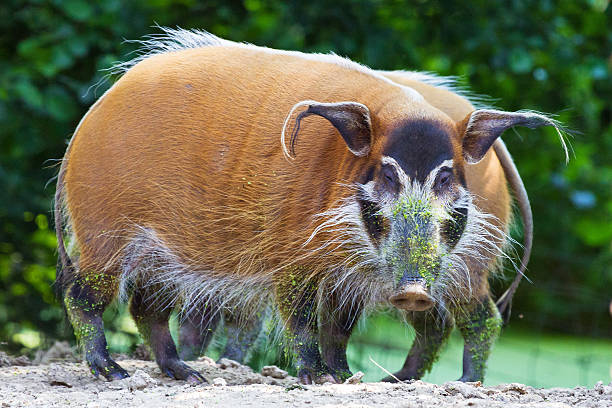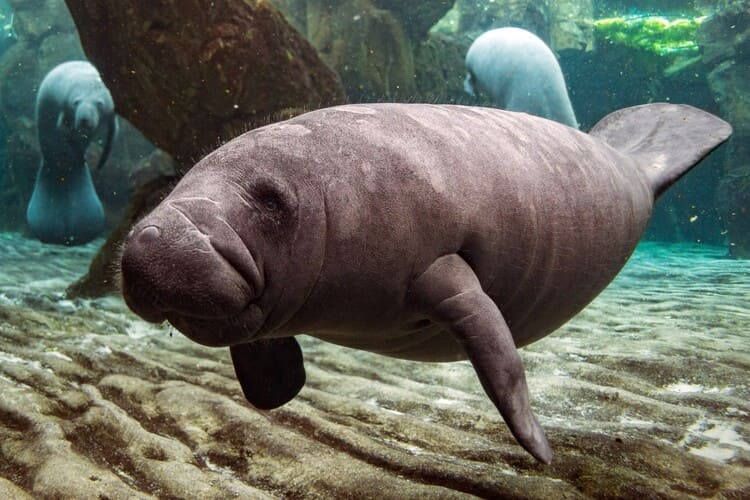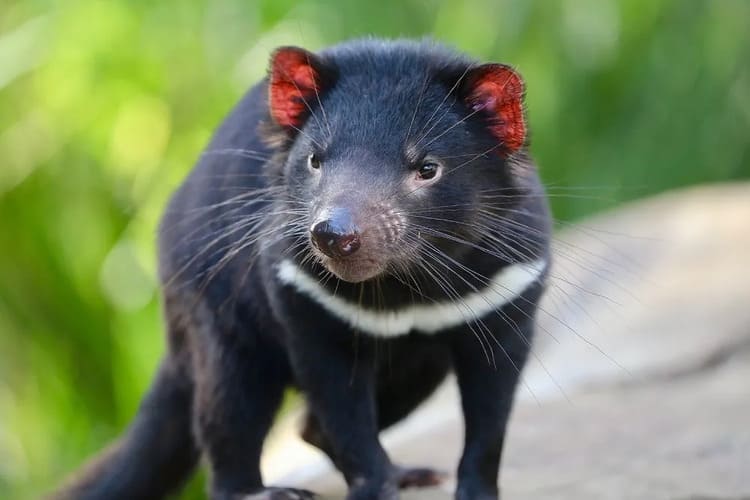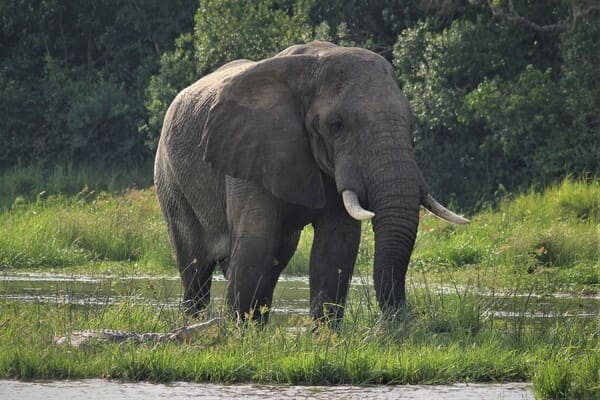red river hog (Potamochoerus porcus)
IUCN
LCBasic Information
Scientific classification
- name:red river hog (Potamochoerus porcus)
- Scientific Name:
- Outline:Mammal
- Family:p.porcus
Vital signs
- length:3.5 - 5 feet
- Weight:100 -285 pounds
- lifetime:10-15 years
Feature
Known for its vibrant red coat and striking facial markings, it is one of the most colorful and unique wild pigs in the world
Distribution and Habitat
The Red River Hog is native to the dense forests, savannas, and wetlands of sub-Saharan Africa. They prefer areas with plenty of vegetation and access to water, such as tropical rainforests, swamps, and riverbanks
Appearance
Its body is covered in coarse fur, and its face is adorned with white markings, including a stripe that runs from the nose to the top of the head. These markings, along with its sharp, pointed ears tipped with tufts of black hair
Details
Table of Contents
Physical Characteristics
Habitat and Environment
Behavior, Lifestyle, and Diet
Geographic Distribution
Reproduction, Parenting, and Lifespan
Subspecies and Variations
Conservation Status
Protection Levels
Population Trends
Predators of the Red River Hog
References
FAQs
Species Scientific Classification of the Red River Hog
The Red River Hog is scientifically classified as follows:
Kingdom: Animalia
Phylum: Chordata
Class: Mammalia
Order: Artiodactyla
Family: Suidae
Genus: Potamochoerus
Species: Potamochoerus porcus
The Red River Hog is a member of the pig family (Suidae) and is closely related to the bushpig (Potamochoerus larvatus). Known for its vibrant red coat and striking facial markings, it is one of the most colorful and unique wild pigs in the world.
1. Physical Characteristics of the Red River Hog
The Red River Hog is famous for its vibrant reddish-orange coat, which helps it stand out among wild pig species. Its body is covered in coarse fur, and its face is adorned with white markings, including a stripe that runs from the nose to the top of the head. These markings, along with its sharp, pointed ears tipped with tufts of black hair, give it a striking appearance.

Adult Red River Hogs typically weigh between 100 to 285 pounds and measure about 3.5 to 5 feet in length. They have a compact, muscular build with short legs and a relatively long snout, which they use for rooting through soil in search of food. Their tusks are small and not as prominent as those of other wild pig species, but they are still useful for digging and self-defense.
2. Habitat and Environment of the Red River Hog
The Red River Hog is native to the dense forests, savannas, and wetlands of sub-Saharan Africa. They prefer areas with plenty of vegetation and access to water, such as tropical rainforests, swamps, and riverbanks. These environments provide both food and cover, allowing them to avoid predators effectively.
Red River Hogs are highly adaptable and can survive in a variety of habitats as long as there is adequate food and water. They are often found near human settlements, where they scavenge for food, but this behavior sometimes brings them into conflict with farmers.
3. Behavior, Lifestyle, and Diet of the Red River Hog
Red River Hogs are primarily nocturnal animals, becoming most active at night to forage for food. They are social creatures, living in groups called sounders, which typically consist of 6 to 20 individuals. These groups are led by a dominant male and include females and their offspring.
Their diet is omnivorous, consisting of fruits, roots, tubers, insects, small mammals, and carrion. Red River Hogs are excellent foragers, using their strong snouts to dig through soil and leaf litter. They also scavenge near human settlements, sometimes raiding crops, which has led to their reputation as agricultural pests in some areas.
Despite their social nature, they can be aggressive when threatened, using their tusks and strength to defend themselves or their group.
4. Geographic Distribution of the Red River Hog
The Red River Hog is widely distributed across sub-Saharan Africa, particularly in regions with dense vegetation and ample water sources. Countries where they are commonly found include:
Gabon
Congo
Cameroon
Nigeria
Ghana
Unlike other wild pigs, they are not migratory and tend to stay within a well-defined home range. However, their range may overlap with that of the closely related bushpig in some areas.
5. Reproduction, Parenting, and Lifespan of the Red River Hog
Red River Hogs have a polygynous mating system, where dominant males mate with multiple females within their group. The breeding season usually aligns with the rainy season, when food is abundant. Females have a gestation period of about 120 days, after which they give birth to a litter of 3 to 6 piglets in a well-hidden nest.
Piglets are born with brown coats and lighter stripes for camouflage, which fade as they mature. The mother is highly protective and will nurse her young for several months until they are ready to forage independently.
In the wild, Red River Hogs typically live 10 to 15 years, but in captivity, where they are protected from predators and have access to consistent food and care, they can live up to 20 years.
6. Subspecies and Variations of the Red River Hog
The Red River Hog has no officially recognized subspecies, but there is some variation in size, coat color, and markings depending on their geographic location. Here's an overview of the variations:
| Region | Notable Characteristics | Size Range |
|---|---|---|
| Central Africa | Bright reddish coat with bold markings | Larger, up to 285 pounds |
| West Africa | Slightly duller coat; smaller tusks | Medium, around 200 pounds |
| Eastern Africa | Darker coat with less distinct markings | Smaller, around 150 pounds |
7. Conservation Status of the Red River Hog
Protection Levels
The Red River Hog is listed as a species of Least Concern by the International Union for Conservation of Nature (IUCN). Its population is considered stable due to its adaptability and wide distribution.
Population Trends
Although the overall population is stable, localized declines have been observed due to habitat loss, hunting, and conflicts with humans. In some regions, they are hunted for bushmeat, which poses a threat to their long-term survival.
8. Predators of the Red River Hog
Despite their size and strength, Red River Hogs face predation from large carnivores, including:
Young piglets are particularly vulnerable and may also be targeted by smaller predators such as eagles and snakes. To protect themselves, Red River Hogs rely on their speed, group defense tactics, and their ability to hide in dense vegetation.
9. References
International Union for Conservation of Nature (IUCN). (2023). Red River Hog Status
Smithsonian National Zoo. (2023). Red River Hog Facts
African Wildlife Foundation. (2023). Wild Pigs of Africa
FAQ
1. What do Red River Hogs eat?
Red River Hogs are omnivorous. Their diet includes fruits, roots, tubers, insects, small mammals, and even carrion. They are excellent foragers and often use their strong snouts to dig for food.
2. Where do Red River Hogs live?
Red River Hogs are native to sub-Saharan Africa and thrive in dense forests, savannas, and wetlands. They prefer areas with plenty of vegetation and water, often near riverbanks or swamps.
3. How long do Red River Hogs live?
In the wild, Red River Hogs live 10 to 15 years. In captivity, with better protection and care, they can live up to 20 years.








